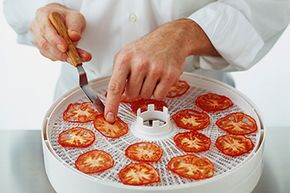Dehydrated Food at Home
You don't need big, fancy machinery to dehydrate your own food at home. In fact, most people already have everything they need to get started. The only three things that are required are heat to push out moisture, dry air to absorb it and air movement to carry it off.
A simple way to dehydrate food is to take a page from our ancestors' book and dry it in the sun. This technique is basically free: All you need is about three to four days of direct sunlight and humidity levels below 20 percent [source: Jopp]. Unfortunately, this precludes much of the United States (with the exception of the desert Southwest), where cool and moist conditions could cause mold growth before the dehydration process is complete.
Advertisement
Food can also be air dried, which is done indoors. Great candidates for this method are herbs, hot peppers and mushrooms, which should be threaded on string or tied in bunches and hung, like in the stillhouses of medieval times. Slap on a paper bag for dust protection, and you're ready to go.
If you want to kick the technology up a notch, but not the cost, try dehydrating with your oven. Heat the oven to 140 degrees Fahrenheit (60 degrees Celsius), prop the door open a couple of inches and set up a fan to blow across the opening. Place the food in a single layer on a cookie sheet. Drying times can range from one hour for herbs to 48 hours for juicy, meaty fruits like peaches [source: Boyer and Huff]. Microwave ovens can be used as well, but only for herbs. Place several branches between paper towels, and you should have dry, brittle herbs in just two or three minutes.
Finally, you can purchase a home dehydrator, which generally consists of a heating element, a fan for air circulation and trays on which you arrange the food. Like oven drying, this method produces results ranging from a couple of hours to a couple of days, depending on the food. Dehydrators usually produce the best results, but they can cost you anywhere from $40 to $350.
With any of these methods, proper preparation is essential. For instance, some foods are better blanched before they are dehydrated. And meat is particularly tricky, as it must be trimmed of all fat and cooked before dehydrating. There are plenty of great websites with preparation tips and drying times, so be sure to check those out if you get serious about trying dehydration.
Dehydrated Food FAQ
How do you dehydrate food?
How long do dehydrated foods last?
What is the purpose of dehydrating food?
What are the best vegetables to dehydrate?
Is it worth buying a food dehydrator?
Author's Note: How Dehydrated Food Works
A week before my deadline for this article, I spent three nights in the Grand Staircase-Escalante National Monument. On the menu for dinner? Lasagna with meat sauce, chicken teriyaki and the consensus favorite, chicken fajita filling — all freeze-dried. Once rehydrated, I thought the flavor and texture of the meat, vegetables, noodles and grains was surprisingly close to what I might eat fresh at home. But maybe I was just really hungry from a full day of hiking.
Related Articles
More Great Links
Sources
- Adam, Katherine L. "Food Dehydration Options." National Sustainable Agriculture Information Service. August 2004. (April 7, 2015) http://well95490.org/wp-content/uploads/library/plan_it_green_toolkit/food_and_permaculture/permaculture_resources/animal_systems/food%20dehydrattion%20options.pdf
- Boyer, Renee and Karleigh Huff. "Using Dehydration to Preserve Fruits, Vegetables, and Meats." Virginia Cooperative Extension. June 1, 2009. (April 8, 2015) http://pubs.ext.vt.edu/348/348-597/348-597.html
- Coffman, Melodie Anne. "The Disadvantages of Dried Fruit." SF Gate. (April 8, 2015) http://healthyeating.sfgate.com/disadvantages-dried-fruit-3227.html
- Encyclopedia Britannica. "Dehydration: Food Preservation." May 18, 2014. (April 6, 2015) http://www.britannica.com/EBchecked/topic/156046/dehydration
- Francis, Frederick J. "Wiley Encyclopedia of Food Science and Technology – Second Edition." Wiley. October 1999.
- Jopp, LouAnn. "Methods for Drying Food at Home." University of Minnesota Extension. 2011. (April 6, 2015) http://www.extension.umn.edu/food/food-safety/preserving/drying/methods-for-drying-food-at-home/
- Kendall, P. and L. Payton. "Cost of Preserving and Storing Food." August 2008. (April 7, 2015) http://www.ext.colostate.edu/pubs/foodnut/08704.html
- Kirchheimer, Sid. WebMD News Archive. "Fructose May Cause Digestive Problems." WebMD. July 14, 2003. (April 8, 2015) http://www.webmd.com/digestive-disorders/news/20030714/fructose-may-cause-digestive-problems
- Lovegren, Sylvia. "Fashionable Food: Seven Decades of Food Fads." The University of Chicago Press Books. June 2006.
- Mountain House. "Freeze Drying Process." Mountain House. (April 10, 2015) http://www.mountainhouse.com/M/frzdry.html
- Nummer, Brian A. "Historical Origins of Food Preservation." National Center for Home Food Preservation. May 2002. (April 6, 2015) http://nchfp.uga.edu/publications/nchfp/factsheets/food_pres_hist.html
- Nutritional Sciences – University of Missouri Extension. "Food Preservation: Drying Foods." (April 6, 2015) http://extension.missouri.edu/explorepdf/hesguide/foodnut/gh1562.pdf
- Prescott, Samuel C. and Bernard E. Proctor. "Food Technology." McGraw-Hill. 1937.
- Ray, C. Claiborne. "Fruit, Cut and Dried." The New York Times. July 1, 2008. (April 9, 2015) http://www.nytimes.com/2008/07/01/science/01qna.html
- Schalau, Jeff. "Preserving your Summer Harvest." The Backyard Gardener. June 20, 2001. (April 7, 2015) https://ag.arizona.edu/yavapai/anr/hort/byg/archive/foodpreservation.html
- The Backcountry Chef. "What Foods are Worth Dehydrating?" The Backcountry Chef. (April 10, 2015) http://thebackcountrychef.com/food-dehydrating-part-2/
- Todd, Robert B. "Clinical Lecture at King's College Hospital." Medical Times and Gazette. Jan. 3, 1852. (April 9, 2015) https://books.google.com/books?id=CbdXAAAAMAAJ&printsec=frontcover&vq=masson%2520head%2520gardener%2520of%2520the%2520horticultural%2520society%2520of%2520paris
- University of Nebraska-Lincoln Food Team. "How Food Spoils." University of Nebraska-Lincoln. (April 8, 2015) https://food.unl.edu/safety/spoilage
- Vega-Mercado, Humberto et al. "Advances in Dehydration of Foods." Journal of Food Engineering. Pages 271-289. 2001. (April 6, 2015) http://ucanr.edu/datastoreFiles/608-215.pdf
